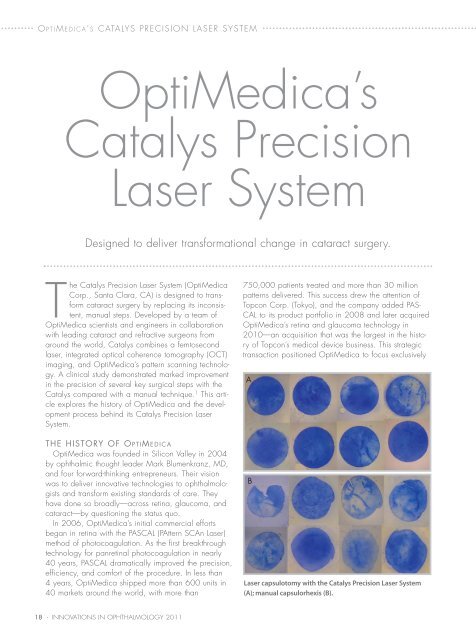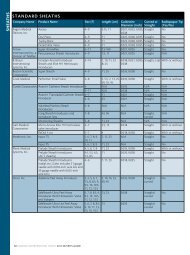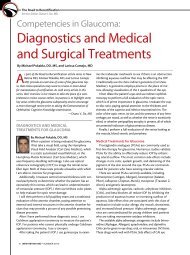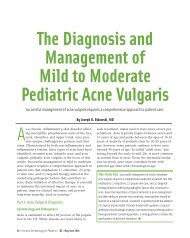OptiMedica's Catalys Precision Laser System
OptiMedica's Catalys Precision Laser System
OptiMedica's Catalys Precision Laser System
You also want an ePaper? Increase the reach of your titles
YUMPU automatically turns print PDFs into web optimized ePapers that Google loves.
O PTIM EDICA’ S<br />
CATALYS PRECISION LASER SYSTEM<br />
OptiMedica’s<br />
<strong>Catalys</strong> <strong>Precision</strong><br />
<strong>Laser</strong> <strong>System</strong><br />
Designed to deliver transformational change in cataract surgery.<br />
The <strong>Catalys</strong> <strong>Precision</strong> <strong>Laser</strong> <strong>System</strong> (OptiMedica<br />
Corp., Santa Clara, CA) is designed to transform<br />
cataract surgery by replacing its inconsistent,<br />
manual steps. Developed by a team of<br />
OptiMedica scientists and engineers in collaboration<br />
with leading cataract and refractive surgeons from<br />
around the world, <strong>Catalys</strong> combines a femtosecond<br />
laser, integrated optical coherence tomography (OCT)<br />
imaging, and OptiMedica’s pattern scanning technology.<br />
A clinical study demonstrated marked improvement<br />
in the precision of several key surgical steps with the<br />
<strong>Catalys</strong> compared with a manual technique. 1 This article<br />
explores the history of OptiMedica and the development<br />
process behind its <strong>Catalys</strong> <strong>Precision</strong> <strong>Laser</strong><br />
<strong>System</strong>.<br />
THE HISTORY OF OPTIM EDICA<br />
OptiMedica was founded in Silicon Valley in 2004<br />
by ophthalmic thought leader Mark Blumenkranz, MD,<br />
and four forward-thinking entrepreneurs. Their vision<br />
was to deliver innovative technologies to ophthalmologists<br />
and transform existing standards of care. They<br />
have done so broadly—across retina, glaucoma, and<br />
cataract—by questioning the status quo.<br />
In 2006, OptiMedica’s initial commercial efforts<br />
began in retina with the PASCAL (PAttern SCAn <strong>Laser</strong>)<br />
method of photocoagulation. As the first breakthrough<br />
technology for panretinal photocoagulation in nearly<br />
40 years, PASCAL dramatically improved the precision,<br />
efficiency, and comfort of the procedure. In less than<br />
4 years, OptiMedica shipped more than 600 units in<br />
40 markets around the world, with more than<br />
750,000 patients treated and more than 30 million<br />
patterns delivered. This success drew the attention of<br />
Topcon Corp. (Tokyo), and the company added PAS-<br />
CAL to its product portfolio in 2008 and later acquired<br />
OptiMedica’s retina and glaucoma technology in<br />
2010—an acquisition that was the largest in the history<br />
of Topcon’s medical device business. This strategic<br />
transaction positioned OptiMedica to focus exclusively<br />
A<br />
B<br />
<strong>Laser</strong> capsulotomy with the <strong>Catalys</strong> <strong>Precision</strong> <strong>Laser</strong> <strong>System</strong><br />
(A); manual capsulorhexis (B).<br />
18 • INNOVATIONS IN OPHTHALMOLOGY 2011
O PTIM EDICA’ S<br />
CATALYS PRECISION LASER SYSTEM<br />
A<br />
B<br />
The view of the laser capsulotomy from<br />
the <strong>Catalys</strong>’ video system.<br />
A <strong>Catalys</strong> <strong>Precision</strong> <strong>Laser</strong> <strong>System</strong> capsulotomy at 1-month follow-up (A).<br />
A manual capsulorhexis at 1-month follow-up (B).<br />
on the development of its <strong>Catalys</strong> <strong>Precision</strong> <strong>Laser</strong><br />
<strong>System</strong>, which it had begun in 2004.<br />
PRECISION LASER SYSTEM<br />
Expected to launch worldwide in 2011, <strong>Catalys</strong> is<br />
poised to deliver to cataract surgeons the same winning<br />
combination of precision, control, performance,<br />
safety, and efficacy that OptiMedica delivered in retina<br />
and glaucoma with PASCAL. <strong>Catalys</strong> is designed to<br />
replace the most manual steps of cataract procedures<br />
by providing custom control of capsulotomy size, shape<br />
and position; precise lens fragmentation, including segmentation<br />
and softening; exact laser incisions in the<br />
cornea to address astigmatism; and meticulously constructed<br />
multiplane cataract incisions.<br />
Throughout the development of <strong>Catalys</strong>, OptiMedica<br />
has made numerous technology choices aimed at delivering<br />
unparalleled precision. The system is docked to<br />
the patient via the Liquid Optics Interface, which was<br />
designed as part of the optical path for the OCT and<br />
laser and provides a wide field of view for the surgeon.<br />
Additionally, sophisticated algorithms enhance<br />
<strong>Catalys</strong>’ integrated OCT. This system, called Integral<br />
Guidance (INTEGRated ALgorithms), automatically identifies<br />
ocular surfaces and establishes safety zones that<br />
allow the physician to select and customize the treatment,<br />
ensuring that the femtosecond laser pulses are<br />
delivered precisely to the intended location.<br />
RESULTS<br />
The clinical results achieved with <strong>Catalys</strong> have established<br />
numerous benefits for use in cataract surgery.<br />
Data from a prospective, randomized, 29-patient study<br />
showed that <strong>Catalys</strong> delivered marked improvement<br />
over manual techniques across a number of key measures,<br />
including capsulotomy size, shape, and ease of<br />
lens fragmentation and disassembly. 1 Capsulotomy size<br />
was measured by deviation of excised capsule disc<br />
diameter from the intended target. The average deviation<br />
in capsular disc diameter with <strong>Catalys</strong> was 27 µm,<br />
whereas the average deviation with the manual technique<br />
was 339 µm (P < .001). Capsulotomies delivered<br />
with <strong>Catalys</strong> and manually had a mean circularity<br />
of 0.942 and 0.774, respectively (P < .001); a score<br />
of 1.0 represented perfect circularity of the capsulotomy<br />
shape. Ease of lens fragmentation and disassembly<br />
was measured by cumulative dissipated energy (CDE)<br />
during ultrasound phacoemulsification. The observed<br />
CDE used for ultrasound phacoemulsification of the lens<br />
for laser-treated eyes (11.58 CDE) was significantly<br />
less than for the control eyes (18.54 CDE; P = .028).<br />
<strong>Catalys</strong> also delivered excellent capsulotomy centration.<br />
Using the target of centration within the dilated<br />
pupil, <strong>Catalys</strong> achieved an average distance from the<br />
intended center of 81 ±46 µm.<br />
“The significant gains in precision we<br />
were able to achieve in the clinical<br />
study with <strong>Catalys</strong> represent an<br />
incredibly exciting development in the<br />
field of cataract surgery.”<br />
— William W. Culbertson, MD<br />
These results have promising implications for improving<br />
patient outcomes, OptiMedica medical advisory<br />
board chair William W. Culbertson, MD, of the<br />
Bascom Palmer Eye Institute, Miller School of Medicine,<br />
University of Miami, said. “The significant gains in precision<br />
we were able to achieve in the clinical study<br />
INNOVATIONS IN OPHTHALMOLOGY 2011 • 19
O PTIM EDICA’ S<br />
CATALYS PRECISION LASER SYSTEM<br />
“I can’t think of a more exciting time to be in ophthalmology. We are in the midst<br />
of a complete landscape change with the dawn of femtosecond laser cataract<br />
surgery, and we could not be more enthusiastic about the potential of our <strong>Catalys</strong><br />
system to dramatically improve the precision of the procedure and thereby deliver<br />
significant benefit to both cataract surgeons and their patients.”<br />
— Mark J. Forchette, president and CEO, OptiMedica<br />
with <strong>Catalys</strong> represent an incredibly exciting development<br />
in the field of cataract surgery. A more precise<br />
procedure should enable cataract surgeons to more<br />
accurately position the IOL, and this is key to visual<br />
outcomes.”<br />
EXPERIENCE<br />
Another crucial area of focus in the development of<br />
<strong>Catalys</strong> was user experience, starting with an understanding<br />
of the workflow requirements for a laser<br />
cataract system. The system’s intuitive and ergonomically<br />
designed hardware and software user controls were<br />
developed with the needs of the patient, surgeon, technician,<br />
and nurse in mind. Its graphical user interface<br />
was built to allow efficient treatment planning. To<br />
achieve these goals, OptiMedica sought input from its<br />
medical advisory and medical staff advisory boards.<br />
The development of <strong>Catalys</strong> has been steered by a<br />
group of outstanding leaders, including Dr. Blumenkranz,<br />
scientific advisor Daniel Palanker, PhD, and a<br />
talented senior management team made up of medical<br />
device executives with more than 190 years of collective<br />
experience. Members of OptiMedica’s current senior<br />
management team have held leadership positions at<br />
companies including Alcon Laboratories, Inc. (Fort<br />
Worth, TX); Boston Scientific (Natick, MA); Coherent,<br />
Inc. (Santa Clara, CA); Guidant (Indianapolis, IN);<br />
IntraLase (now Abbott Medical Optics Inc., Santa Ana,<br />
CA); and Medtronic (Minneapolis, MN). In addition,<br />
the company’s research and development staff, a group<br />
often described as refreshingly “Silicon Valley,” bring to<br />
the <strong>Catalys</strong> project unique technical perspectives and<br />
out-of-the-box thinking.<br />
OptiMedica also has the support of a strong board<br />
of directors, led by chairman Brook Byers, as well as a<br />
group of premier venture investors including Kleiner<br />
Perkins Caufield & Byers (Menlo Park, CA); Alloy<br />
Ventures (Palo Alto, CA); DAG Ventures (Palo Alto, CA);<br />
BlackRock Private Equity Partners (Plainsboro, NJ); and<br />
Bio*One Capital (Singapore).<br />
“I can’t think of a more exciting time to be in ophthalmology,”<br />
said Mark J. Forchette, president and CEO of<br />
OptiMedica. “We are in the midst of a complete landscape<br />
change with the dawn of femtosecond laser<br />
cataract surgery, and we couldn’t be more enthusiastic<br />
about the potential of our <strong>Catalys</strong> system to dramatically<br />
improve the precision of the procedure and thereby<br />
deliver significant benefit to both cataract surgeons and<br />
their patients.” ●<br />
The <strong>Catalys</strong> <strong>Precision</strong> <strong>Laser</strong> <strong>System</strong> is not for sale in<br />
the United States.<br />
The <strong>Catalys</strong> <strong>Precision</strong> <strong>Laser</strong> <strong>System</strong><br />
1. Palanker D, Blumenkranz MS, Anderson D, et al. Femtosecond laser-assisted cataract<br />
surgery with integrated optical coherence tomography. Sci Transl Med. 2010;2:58ra85.<br />
20 • INNOVATIONS IN OPHTHALMOLOGY 2011

















